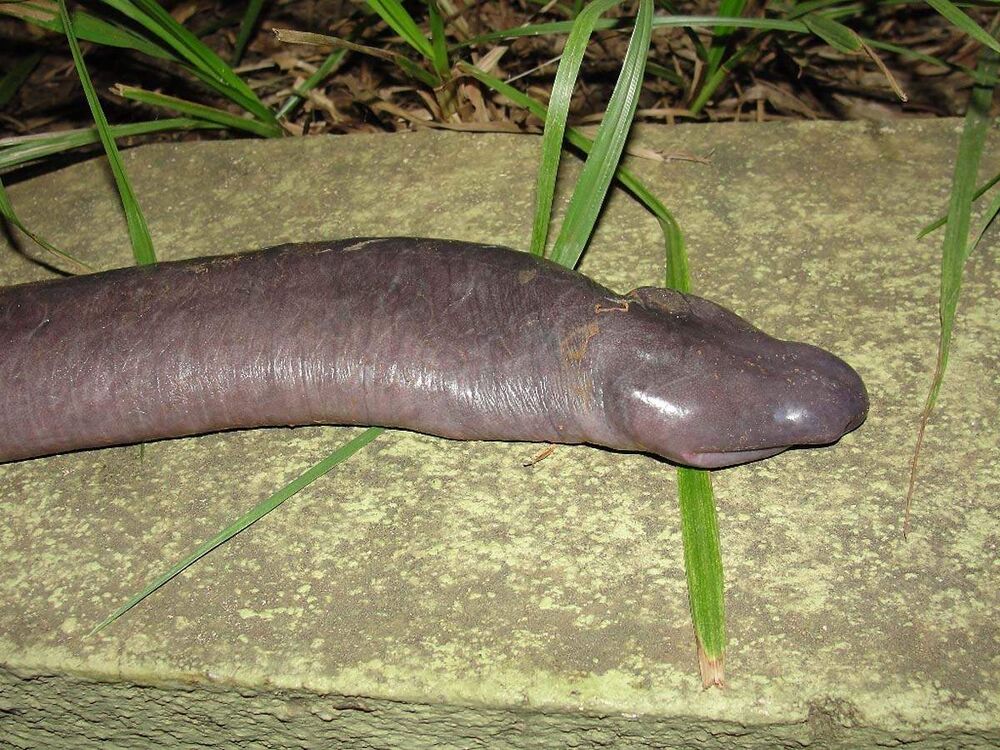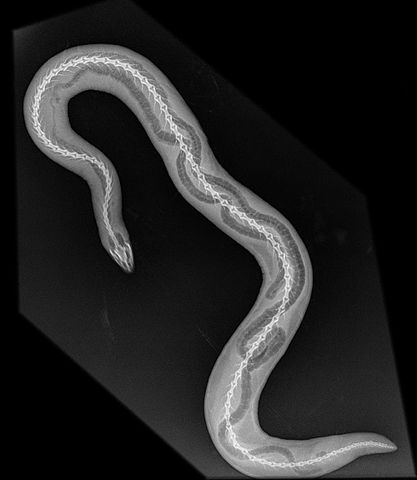Caecilians - The Blind Ones
Usually, when someone mentions amphibians, we picture a frog, maybe a toad
or perhaps a salamander… also a newt. But unless you’re a true herpeto-nerd (which is a good thing),
you definitely don’t picture something limbless and almost blind, right?

Photo: Uraeotyphlus narayani by Venu Govindappa
You will, from now on!
The amphibians that I am about to present
to you truly are limbless, they are subterranean, and they’re called caecilians,
which means ‘blind ones’ in Latin. Truly, these creatures don’t really see a
lot – some species don’t even have eyes, and those that do can only use them
to tell the difference between light and dark.
Though mostly small in size, some caecilians, namely the largest species, Caecilia thompsoni, can grow to a staggering 1.5 meters in length. On the contrary, the tiny Idiocranium russeli can produce offspring at a length below 8 cm!
These serpentine fellas are often mistaken for snakes or for worms, the latter especially by people who truly believe that ‘you are what you eat’, since caecilians mostly feed on earthworms. They also eat ground-dwelling worms and insects, such as termites or even small vertebrates, all of which they capture with their needle-like teeth and swallow them whole. Photographer Alejandro Arteaga managed to take a snap of the giant caecilian (Caecilia thompsoni) that makes it look like it’s auditioning for the role of the mouth-inside-mouth in Alien.
The giant caecilian & other cool Ecuador finds! by @TropicalHerping https://t.co/RESCGFwja5 pic: Alejandro Arteaga pic.twitter.com/7kwZ1I5erm
— Sarah Keartes (@sarahkeartes) January 29, 2019
Human Creativity vs. Limbless Organisms
As it goes with most animal groups, they always have a superstar species among them.
And as it sometimes goes with strange limbless animals,
at least one caecilian has been compared to a phallus and
even called ‘man-aconda’, ‘penis snake’ or ‘floppy snake’. Truly creative.
The species in question is Atretochoana eiselti. You might have guessed that it’s neither a snake, nor a penis. Although its resemblance to an (unrealistically large) anatomical structure of a male human is truly uncanny, there’s something else about this amphibian that should astonish people instead. At 72-81 cm in length, A. eiselti is the largest tetrapod to completely lack lungs, and it is the only lungless caecilian! It was thought that a small caecilian, then Caecilita iwokramae, now Microcaecilia iwokramae, was also lungless, which was later disproved - it has one (right) fully developed lung. Gotta love a healthy amount of confusion in science!

Photo credit: Hookmoed et al. 2011
It is unclear why this species is completely lungless – not many specimens have been
found and studied thus far. We do know that the species is aquatic and that its
skin is responsible for gas exchange between its body and the environment - this is called 'cutaneous respiration'.
Hookmoed et al., who most recently studied the species, believe that the wrinkled skin
of the amphibian could make respiration more efficient by maximising the skin's surface.
The strange thing is, however, that A. eiselti does not live in cold waters as one would expect (lungless salamanders, its closest completely lungless relatives, do not live in warm waters). Instead, it can be found in warm, fast-flowing waters of the Amazon Basin in Brazil and, perhaps, in Bolivia, too. The logic behind this expectation is obvious: cold water is more oxygen-rich, and that is an important feature for a creature that relies on cutaneous respiration.
In their 2011 study, Hookmoed et al. found and described three live specimens. The scientists could not resolve the question of how exactly this species breathes. It seems that cutaneous respiration does take place, since only two or three cells divide the animal’s blood from the surface of its skin. However, the fact that the animal is truly large makes it a bit hard to believe that the species could get enough oxygen this way. It is possible that they also use buccopharyngeal (i.e. pertaining to the cheeck/mouth and the pharynx), intestinal or even cloacal respiration to get more access to oxygen. Makes me wonder even more as to why man-aconda lost its lungs during its evolutionary journey. Sure, if you’re an animal that lives in deep waters, your lungs could make it harder for you to remain deep, so losing them may solve the buoyancy problem. There's just one thing that goes against this argument: its closest known relative, Typhlonectes compressicauda, also lives in deep waters but still has a pair of well-developed lungs! So what's up with A. eiselti? Is it possible that lunglessness evolved in this species because lungs constrained the evolution of a specialized feeding apparatus, as argued by Wilkins & Nussbaum? We need answers!
They’re Not Fish in the Atlantic, but They Are Slippery
Grabbing a caecilian may be difficult. They’re slimy and slip like a bar of soap. A common species in Argentina, Bolivia, Brazil and Paraguay, Siphonops paulensis, also known as Boettger's caecilian, produces slime that even contains toxins that can damage red blood cells in their would-be predators. Since their skin is very sensitive, just like the skin of other amphibians, and is prone to dermatitis, it’s better to avoid touching them altogether.
Truly Unique
No matter how much you think caecilians look like a penis, you should know that they have a penis-like cloacal structure, phallodeum. And that’s pretty unique among amphibians. Actually, caecilians are the only group of amphibians that strictly reproduce by internal fertilization, unlike e.g. frogs who first release the eggs that become fertilized externally.
And their uniqueness does not stop there!
Awesome Parents
About 25% of caecilian species lay eggs. The rest are viviparous - they give birth to live young.
All offspring are given proper maternal care for the first few weeks of their lives. Caecilian mothers produce a thick fat- and nutrient-filled layer of skin that serves as food for their young. Mothers in some species have skin that’s twice as thick as the skin of females with no offspring!
Juvenile caecilians have adapted teeth for dermatotrophy (as this skin-eating behavior is called), and in some viviparous species, the young have specialized teeth that they use to feed on the thickened lining of their mother’s oviduct! They eat bits of their mother before they are born!
This is the mother caecilian (a limbless amphibian) feeding her nutrient rich skin to her babies you were looking for ...
— Russ McSpadden (@PeccaryNotPig) January 26, 2020
🎥 @willwbooker
pic.twitter.com/pCwgAiueGR
Ripped Jaws
It’s not just their teeth that got pumped up by evolution. They have a pretty badass jaw musculature, too. In fact, they have two sets of jaw-closing muscles (twice as many as most animals) that, together with a pointed snout and thick skull help them burrow more efficiently and feed safely in their burrow without risking jaw dislocation. They often feed by long-axis body rotation, and the spinning force is even greater than their bite force. Spinning allows caecilians to measure prey mass (since they can't really see it) and reduce oversized prey to a size they can swallow.
Tentacled Snout
Caecilians are the only known amphibians to possess tentacles! Actually, the only other vertebrate to possess tentacles is the star-nosed mole (Condylura cristata). A pair of these sensory organs is placed on their snout and allows them to detect the presence of prey-produced chemicals in the soil in which they burrow. This way, they can find food very quickly and navigate better in their dark subterranean world because they're able to smell their prey even when their nostrils are closed during burrowing.
With currently about 215 species described - the latest being Caecilia pulchraserra, discovered in 2019 - caecilians represent a small group of amphibians that deserve much more than just being compared to male reproductive organs. IUCN lists caecilians as data-deficient.

Photo credit: Tobias von Anhalt
| Scientific name: | Atretochoana eiselti |
| Phylum: | Chordata |
| Class: | Amphibia |
| Order: | Gymnophiona |
| Family: | Typhlonectidae |
| Scientific reading: |

Photo credit: Kalumet
X-ray of T. compressicauda
| Common name: | Cayenne caecilian |
| Scientific name: | Typhlonectes compressicauda |
| Phylum: | Chordata |
| Class: | Amphibia |
| Order: | Gymnophiona |
| Family: | Typhlonectidae |
| Scientific reading: |

Photo credit: US NPS
| Scientific name: | Star-nosed mole |
| Scientific name: | Condylura cristata |
| Phylum: | Chordata |
| Class: | Mammalia |
| Order: | Eulipotyphla |
| Family: | Talpidae |
| IUCN status: | Least concern |
| Population trend: | Stable |
| Scientific reading: |